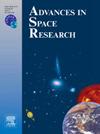统一进近远距离空间交会
IF 2.8
3区 地球科学
Q2 ASTRONOMY & ASTROPHYSICS
引用次数: 0
摘要
远程空间交会是一个复杂的过程,旨在实现后续近距离交会阶段所需的终端条件。在远距离交会中,跟踪飞行器与目标之间的相对动力学是非线性的,这对采用简单的近距离交会轨道控制方法提出了挑战。本文通过角动量和偏心矢量匹配,提出了一种既适用于航天器交会又适用于小天体交会的非线性闭环低推力远程交会律,使跟踪器进入目标轨道平面。这种匹配是通过非线性lyapunov反馈控制实现的,其中跟踪器和目标的角动量和偏心矢量以目标固定-垂直-水平坐标表示。为了减少由此产生的沿航迹偏移,目标半长轴附加沿航迹相关偏差,从而使沿航迹相对距离和速度最终无效。证明了新建立的交会律在小天体引力加速度作用下保持不变性,因此适用于小天体交会。对近地轨道航天器交会和小天体交会的仿真结果表明,所提出的远程交会算法是有效的,可以引导跟踪飞行器接近目标,从而启动近距离交会阶段。本文章由计算机程序翻译,如有差异,请以英文原文为准。
Unified approach to far-range space rendezvous
Far-range space rendezvous is a complex process, designed to achieve terminal conditions required for the subsequent close-range rendezvous phase. In far-range rendezvous, the relative dynamics between the chaser spacecraft and the target are nonlinear, thus challenging the simple orbit control methods used in close-range rendezvous. In this paper, a new nonlinear closed-loop low-thrust far-range rendezvous law applicable to both spacecraft rendezvous and minor celestial body rendezvous is developed by means of angular momentum and eccentricity vector matching, which steers the chaser into the target’s orbital plane. This matching is realized by a nonlinear Lyapunov-based feedback control, in which the chaser and target angular momentum and eccentricity vectors are expressed in target-fixed local-vertical local-horizontal coordinates. In order to reduce the resulting along-track offset, the targeted semimajor axis is appended with an along-track-dependent bias, such that the along-track relative distance and speed are ultimately nullified. It is proven that the newly-developed rendezvous law remains invariant under the gravitational acceleration exerted by a minor celestial body, and is, therefore, applicable to minor celestial body rendezvous. Simulation results for both low Earth orbit spacecraft rendezvous and minor celestial body rendezvous indicate that the proposed far-range rendezvous algorithm is effective, steering the chaser spacecraft to close proximity of the target, thus enabling to initiate the close-range rendezvous phase.
求助全文
通过发布文献求助,成功后即可免费获取论文全文。
去求助
来源期刊

Advances in Space Research
地学天文-地球科学综合
CiteScore
5.20
自引率
11.50%
发文量
800
审稿时长
5.8 months
期刊介绍:
The COSPAR publication Advances in Space Research (ASR) is an open journal covering all areas of space research including: space studies of the Earth''s surface, meteorology, climate, the Earth-Moon system, planets and small bodies of the solar system, upper atmospheres, ionospheres and magnetospheres of the Earth and planets including reference atmospheres, space plasmas in the solar system, astrophysics from space, materials sciences in space, fundamental physics in space, space debris, space weather, Earth observations of space phenomena, etc.
NB: Please note that manuscripts related to life sciences as related to space are no more accepted for submission to Advances in Space Research. Such manuscripts should now be submitted to the new COSPAR Journal Life Sciences in Space Research (LSSR).
All submissions are reviewed by two scientists in the field. COSPAR is an interdisciplinary scientific organization concerned with the progress of space research on an international scale. Operating under the rules of ICSU, COSPAR ignores political considerations and considers all questions solely from the scientific viewpoint.
 求助内容:
求助内容: 应助结果提醒方式:
应助结果提醒方式:


